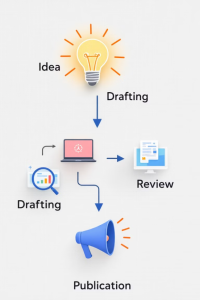Techniques for Creating User Stories and Features in Agile

Introduction
In today’s fast-paced project management environment, the Agile approach has become a key method for adapting to evolving requirements and delivering value iteratively. At the heart of Agile are user stories and features, which serve as the foundation for capturing and managing project needs. This guide provides a thorough understanding of various techniques for creating user stories and features, with a focus on breaking down complex requirements into smaller, more manageable elements.
The Standard Structure of a User Story
A user story is a concise description of a desired feature from the perspective of the end user. It typically follows this standard format:
As a [user type], I want [objective] so that [reason].
This structure highlights three key elements:
-
The type of user the feature concerns
-
The objective or action to be accomplished by the user
-
The reason or value delivered to the user
.
Techniques for Breaking Down User Stories
1. Workflow-Based Decomposition

Split a user story according to the workflow or sequence of steps an end-user follows to achieve their goal, such as:
-
Create a new item in the system
-
Submit for review
-
Validate and approve the item
-
Make the item available to users
2. Business Rule Variations
Divide stories when business rules differ within a single feature. For example, flexible date search for booking could become:
-
Search with a +/- 1-day window
-
Search with a +/- 3-day window
-
Search with strict date requirements
3. Data Variation
If a feature must handle different types of data, split the story according to these variations, such as:
-
Interface in English, French, or Spanish
-
Date formats (DD/MM/YYYY, MM/DD/YYYY)
-
Currency (€, $, £)
4. Interface Variation
When a feature is accessible through multiple interfaces, break down the work accordingly:
-
Mobile app interface
-
Touch-screen kiosk
-
Desktop web application
5. Complexity-Based Decomposition
Separate the simpler parts from the more complex ones, allowing incremental delivery. For instance:
-
Basic search by keyword
-
Category/price filter
-
Advanced filtering and personalisation
6. CRUD Operations
When dealing with data management, decompose by CRUD operations:
-
Create, view, update, delete
-
Forms, detailed views, validation, confirmation, history
7. User Roles
Story differentiation by role, for features with multiple types of users:
-
Employee submits requests
-
Manager approves or rejects
-
HR manages policies
-
Analyst reviews trends
8. Nominal/Alternative Scenarios
Split stories to cover both successful and edge/error cases:
-
Successful login (“happy path”)
-
Incorrect password
-
Unknown user
-
Account lockout after failed attempts
Structuring User Stories
Given-When-Then Format and Acceptance Criteria
Use the Given-When-Then approach to define the conditions, actions, and expected outcomes for a story:
Given I am on the login page
When I enter valid credentials and click “Log In”
Then I am taken to my personal dashboardOn failure:
Show an error message
Lock account after three failed attempts
Acceptance criteria are vital—they set the precise conditions that must be met for a story to be considered ‘Done’, ensuring clarity and shared understanding.
Understanding Features
-
Definition: A feature is a distinct, user-focused capability that delivers specific business value.
-
Hierarchy: Features exist between epics (large, high-level requirements) and user stories (smaller, actionable units).
-
Purpose: Each feature must contribute to business goals and directly respond to user needs.
-
Decomposition: Features are typically broken down into smaller user stories for implementation.
Analogy
Think of requirements as a book:
-
Epic: The whole story
-
Feature: A chapter
-
User Story: A paragraph
-
Task: A single sentence
Identifying Valuable Features
To ensure features truly add value:
-
Gather and analyse user feedback
-
Track usage and performance metrics
-
Conduct user research, interviews, and usability tests
-
Explore new opportunities and pain points
Features should align with stakeholder needs and deliver a significant business impact. Product Managers play a key role in shaping them.
Feature Prioritisation Techniques
-
Weighted Scoring: Assign scores to features based on impact, cost, and business objectives.
-
RICE Method: Rate by Reach, Impact, Confidence, and Effort.
-
Kano Model: Identify “must-haves”, “performance”, and “delighter” features.
-
MoSCoW: Classify as Must have, Should have, Could have, or Won’t have (for now).
-
Story Mapping: Visualise sequences and dependencies.
Prioritisation ensures the most impactful features are tackled first.
What Makes a Good Feature?
-
Tangible and actionable: Clear outcomes and measurable success.
-
User-centred: Addresses a real user need.
-
Independent: Can be delivered without relying on other features.
-
Estimable and testable: Effort can be estimated and test criteria clearly defined.
-
Incrementally deliverable: Can be released piece by piece.
Practical Examples
| Initial User Story | Decomposed User Stories |
|---|---|
| As an editor, I want to publish a blog post | 1. Create post 2. Submit for review 3. Publish post |
| As a traveller, I want to search for flights with flexible dates | 1. Search with date range 2. Search with +/- 1 day 3. Search with +/- 3 days |
| As an athlete, I want to manage my activities | 1. Create 2. Edit 3. Delete |
The INVEST Framework for User Stories
INVEST helps validate the quality of user stories:
-
Independent: Not dependent on others
-
Negotiable: Room for discussion and adaptation
-
Valuable: Delivers tangible value
-
Estimable: Effort can be estimated
-
Small: Achievable in a single sprint
-
Testable: Clear ways to verify completion
Using INVEST ensures user stories are well-formed and ready for development.
Tools for Managing User Stories and Features
Specialised tools can streamline the creation, management, and visualisation of user stories and features, boosting collaboration and productivity. These tools support the full life cycle—from initial mapping to progress tracking and backlog management.

Benefits of a Logical and Consistent Approach
Adopting clear, consistent methods for creating and decomposing user stories and features:
-
Enhances requirements clarity
-
Improves team and stakeholder alignment
-
Reduces rework and misunderstandings
-
Boosts delivery of user value
-
Drives alignment with commercial objectives
Applying these Agile techniques enhances project effectiveness and success.
